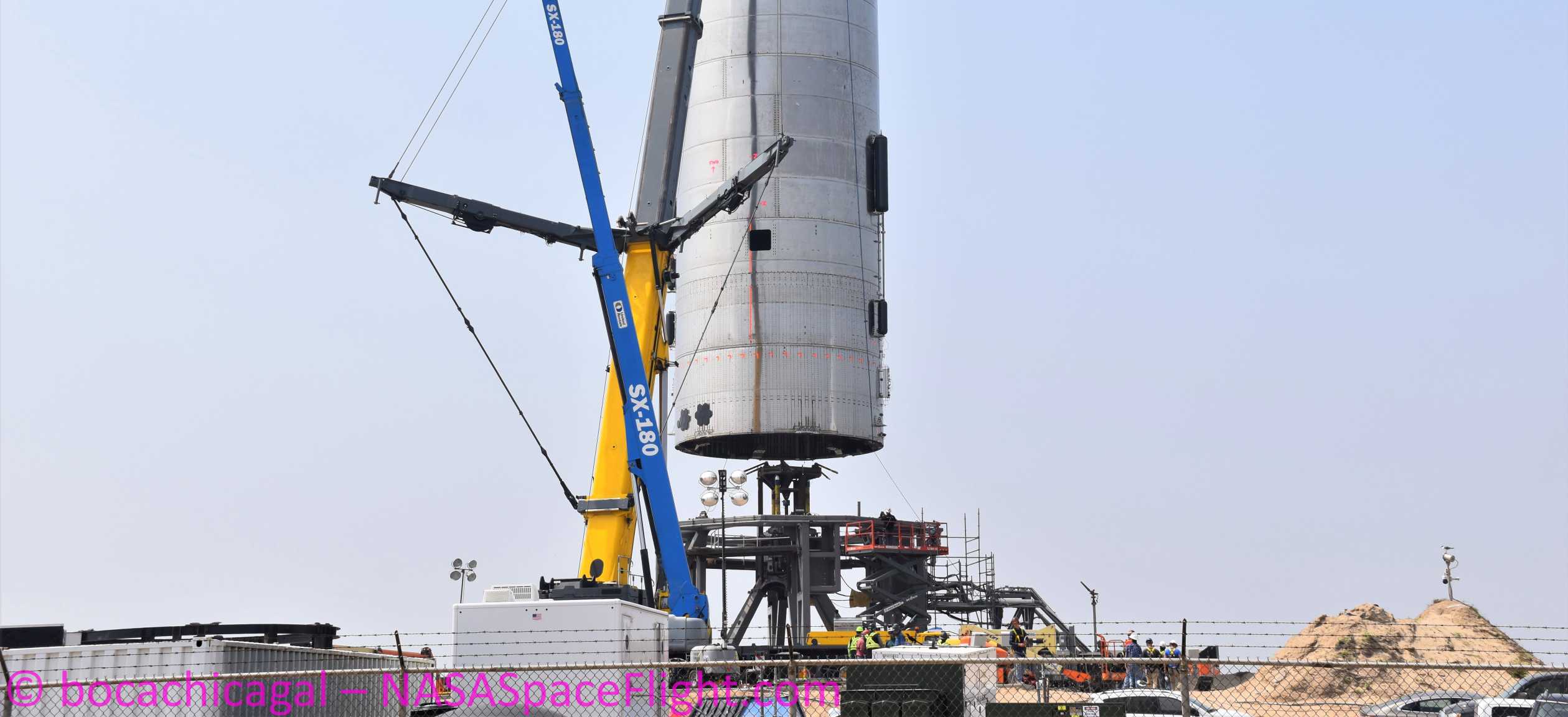
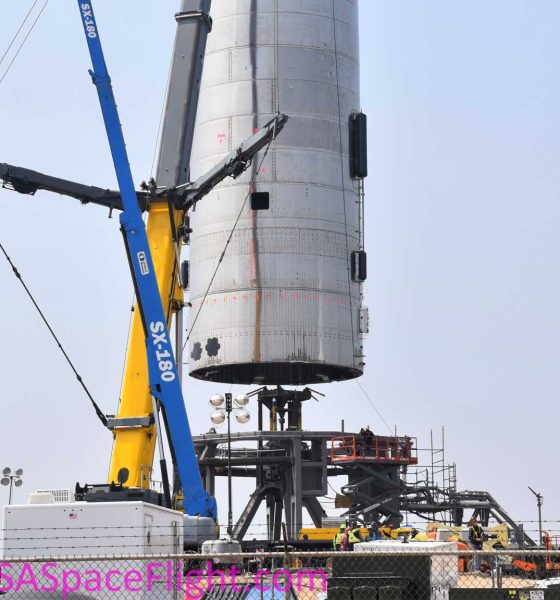
News
SpaceX just finished its third Starship rocket in two months and a fourth is on the way
SpaceX just rolled a completed Starship prototype to the launch pad for the third time in two months and began stacking the next rocket just hours after its assembly facilities were vacated.
SpaceX began building the latest Starship prototype – known as serial number 4 (SN4) – around March 23rd. Exactly 31 days later, SpaceX lifted the vast steel rocket onto a Roll Lift transporter and carried it roughly a mile down the road to the company’s Boca Chica, Texas test and launch facilities. In just a few hours, technicians lifted the rocket off its transporter and onto a fixed launch mount made out of thick steel beams, expediency made possible partly by the addition of new mounting points and hold-down clamps.
Sitting atop the late Starship SN3 prototype’s salvaged skirt, landing leg, and service section, the fate of Starship SN4 remains to be seen and the path it has taken to the pad is paved with the remains of several former prototypes. For the most part, that should be a positive aspect. Given how apparent it is that SpaceX is very quickly learning from past mistakes, SN4 has the best chance yet of successfully passing its proof tests and graduating into Raptor static fire and (perhaps) flight testing. However, if things don’t go as planned, SpaceX is perhaps just a week or two away from completing the next prototype – Starship SN5.
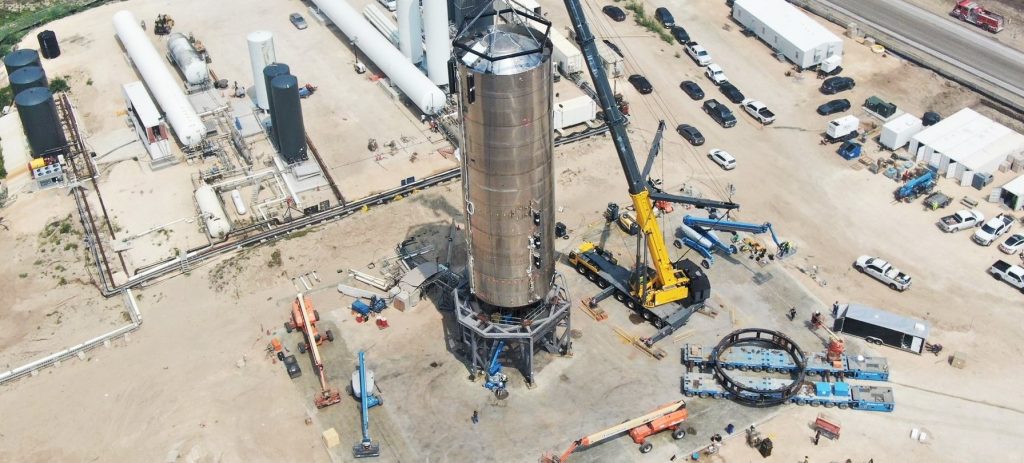
A few hours after SpaceX lifted Starship SN4 onto its steel launch mount, CEO Elon Musk revealed an aerial photo of the rocket and its pad facilities taken with a drone. Recently painted gray and refurbished to undo damage done by Starship SN3’s April 3rd, that mount is currently configured with a strong metal frame and three powerful hydraulic rams. A nearly identical jig was damaged during SN3’s last test when a minor tsunamic of liquid nitrogen – used to safely simulate ultra-cold and explosive liquid oxygen and methane propellant – washed over the mount after the rocket burst.
Much like an ice cube can violently crack and pop when it rapidly changes temperature, untreated steel (almost always cheaper than the alternative) can also be catastrophically damaged by rapid temperature changes (thermal shock). This appears to be exactly what happened to the first hydraulic ram mount, which had visible cracks in photos taken after Starship SN3’s April 3rd demise.
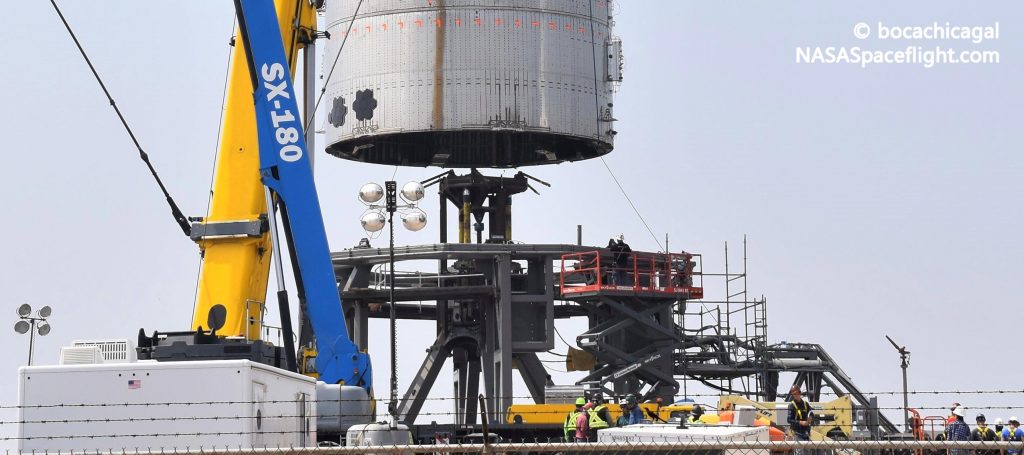
SpaceX appears to have had no issue at all acquiring a replacement in a matter of weeks and it arrived and was installed several days ago. The purpose of the hardware is relatively simple: simulate the stresses one or three Raptor engines will create when ignited and ensure Starship’s ‘thrust puck’ and engine section can survive those stresses while filled with cryogenic liquid methane.
Each ram attaches to the thrust puck with the same hardware an actual Raptor uses, including the rods each engine needs for thrust vector control (TVC; i.e. active steering). In the event that Starship SN4 passes its cryogenic proof test(s) and engine stress simulation(s) with flying colors, SpaceX has already built, acceptance-tested, and shipped three Raptor engines to Boca Chica, where they are waiting inside an assembly tent for their call to action.
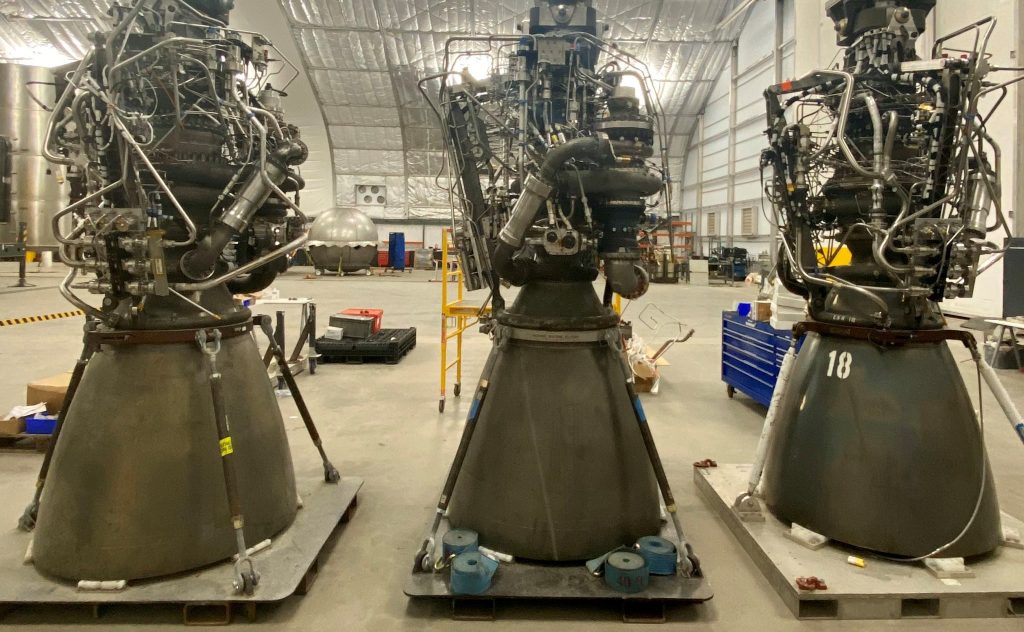
Once a Starship prototype passes acceptance testing and three Raptor engines can be installed, it will be a first for SpaceX’s next-generation rocket engine. For example, if SN4 makes it through testing and is ready to proceed into static fire operations, it will be the first time Raptor has operated in a multi-engine setup – always a significant milestone for any launch vehicle, including SpaceX’s own Falcon 9 and Merlin engines.
In case SN4 does make it to the other side, SpaceX is already prepared with both road closures and NOTAMs (Notices To Airmen) for static fire and hop tests spread out over the next week or so.
Check out Teslarati’s Marketplace! We offer Tesla accessories, including for the Tesla Cybertruck and Tesla Model 3.

News
Tesla is improving Giga Berlin’s free “Giga Train” service for employees
With this initiative, Tesla aims to boost the number of Gigafactory Berlin employees commuting by rail while keeping the shuttle free for all riders.
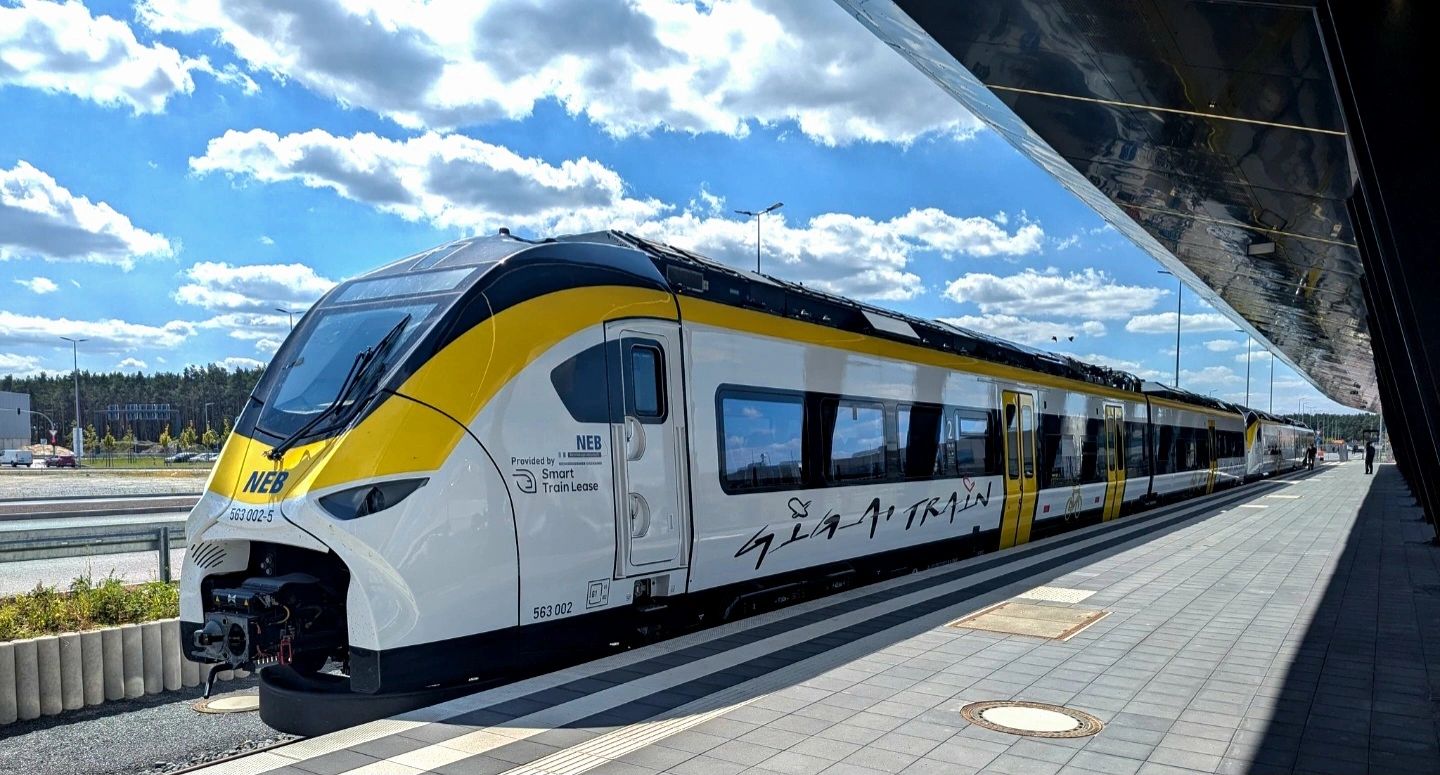
Tesla will expand its factory shuttle service in Germany beginning January 4, adding direct rail trips from Berlin Ostbahnhof to Giga Berlin-Brandenburg in Grünheide.
With this initiative, Tesla aims to boost the number of Gigafactory Berlin employees commuting by rail while keeping the shuttle free for all riders.
New shuttle route
As noted in a report from rbb24, the updated service, which will start January 4, will run between the Berlin Ostbahnhof East Station and the Erkner Station at the Gigafactory Berlin complex. Tesla stated that the timetable mirrors shift changes for the facility’s employees, and similar to before, the service will be completely free. The train will offer six direct trips per day as well.
“The service includes six daily trips, which also cover our shift times. The trains will run between Berlin Ostbahnhof (with a stop at Ostkreuz) and Erkner station to the Gigafactory,” Tesla Germany stated.
Even with construction continuing at Fangschleuse and Köpenick stations, the company said the route has been optimized to maintain a predictable 35-minute travel time. The update follows earlier phases of Tesla’s “Giga Train” program, which initially connected Erkner to the factory grounds before expanding to Berlin-Lichtenberg.
Tesla pushes for majority rail commuting
Tesla began production at Grünheide in March 2022, and the factory’s workforce has since grown to around 11,500 employees, with an estimated 60% commuting from Berlin. The facility produces the Model Y, Tesla’s best-selling vehicle, for both Germany and other territories.
The company has repeatedly emphasized its goal of having more than half its staff use public transportation rather than cars, positioning the shuttle as a key part of that initiative. In keeping with the factory’s sustainability focus, Tesla continues to allow even non-employees to ride the shuttle free of charge, making it a broader mobility option for the area.
News
Tesla Model 3 and Model Y dominate China’s real-world efficiency tests
The Tesla Model 3 posted 20.8 kWh/100 km while the Model Y followed closely at 21.8 kWh/100 km.
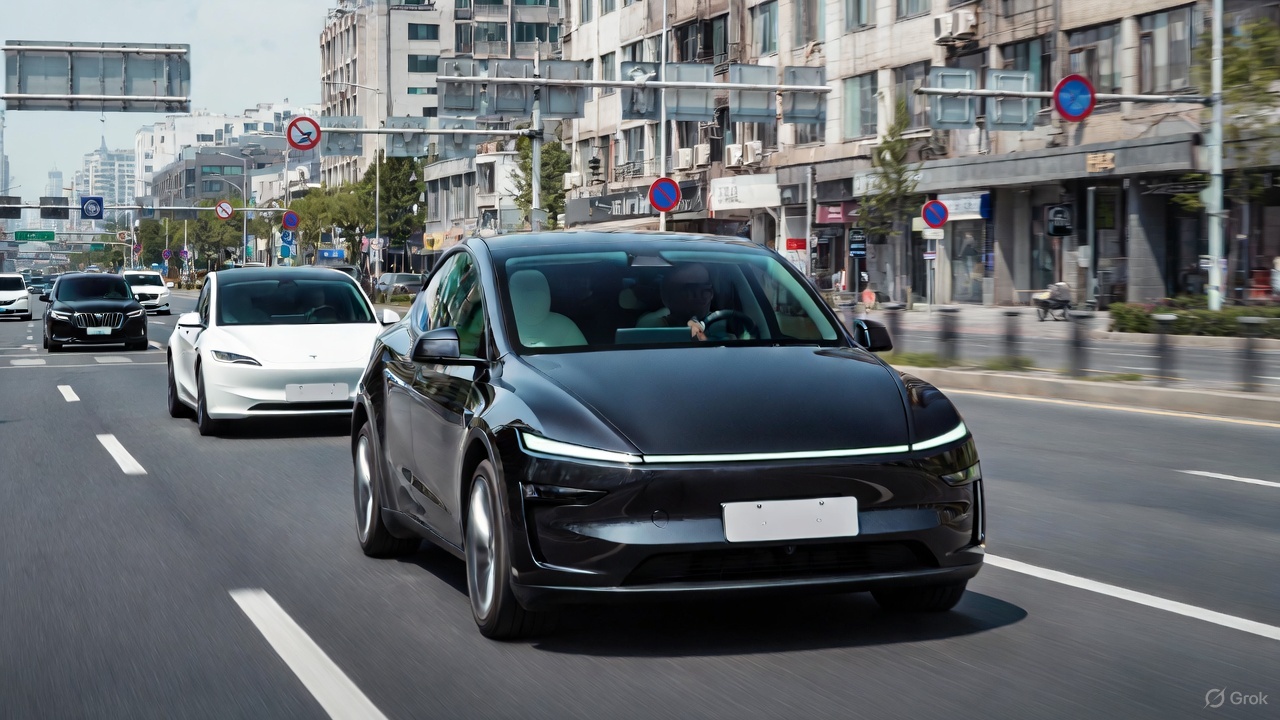
Tesla’s Model 3 and Model Y once again led the field in a new real-world energy-consumption test conducted by China’s Autohome, outperforming numerous rival electric vehicles in controlled conditions.
The results, which placed both Teslas in the top two spots, prompted Xiaomi CEO Lei Jun to acknowledge Tesla’s efficiency advantage while noting that his company’s vehicles will continue refining its own models to close the gap.
Tesla secures top efficiency results
Autohome’s evaluation placed all vehicles under identical conditions, such as a full 375-kg load, cabin temperature fixed at 24°C on automatic climate control, and a steady cruising speed of 120 km/h. In this environment, the Tesla Model 3 posted 20.8 kWh/100 km while the Model Y followed closely at 21.8 kWh/100 km, as noted in a Sina News report.
These figures positioned Tesla’s vehicles firmly at the top of the ranking and highlighted their continued leadership in long-range efficiency. The test also highlighted how drivetrain optimization, software management, and aerodynamic profiles remain key differentiators in high-speed, cold-weather scenarios where many electric cars struggle to maintain low consumption.
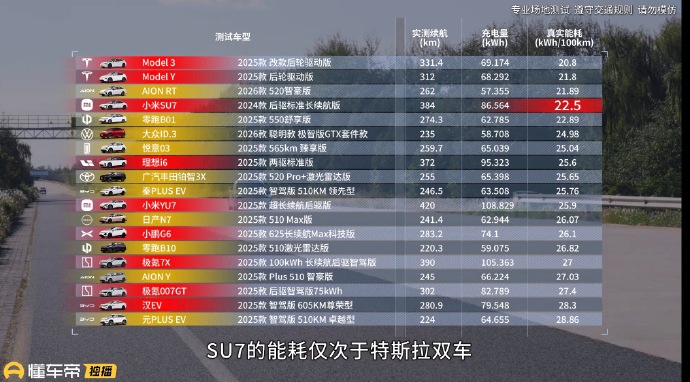
Xiaomi’s Lei Jun pledges to continue learning from Tesla
Following the results, Xiaomi CEO Lei Jun noted that the Xiaomi SU7 actually performed well overall but naturally consumed more energy due to its larger C-segment footprint and higher specification. He reiterated that factors such as size and weight contributed to the difference in real-world consumption compared to Tesla. Still, the executive noted that Xiaomi will continue to learn from the veteran EV maker.
“The Xiaomi SU7’s energy consumption performance is also very good; you can take a closer look. The fact that its test results are weaker than Tesla’s is partly due to objective reasons: the Xiaomi SU7 is a C-segment car, larger and with higher specifications, making it heavier and naturally increasing energy consumption. Of course, we will continue to learn from Tesla and further optimize its energy consumption performance!” Lei Jun wrote in a post on Weibo.
Lei Jun has repeatedly described Tesla as the global benchmark for EV efficiency, previously stating that Xiaomi may require three to five years to match its leadership. He has also been very supportive of FSD, even testing the system in the United States.
Elon Musk
Elon Musk reveals what will make Optimus’ ridiculous production targets feasible
Musk recent post suggests that Tesla has a plan to attain Optimus’ production goals.
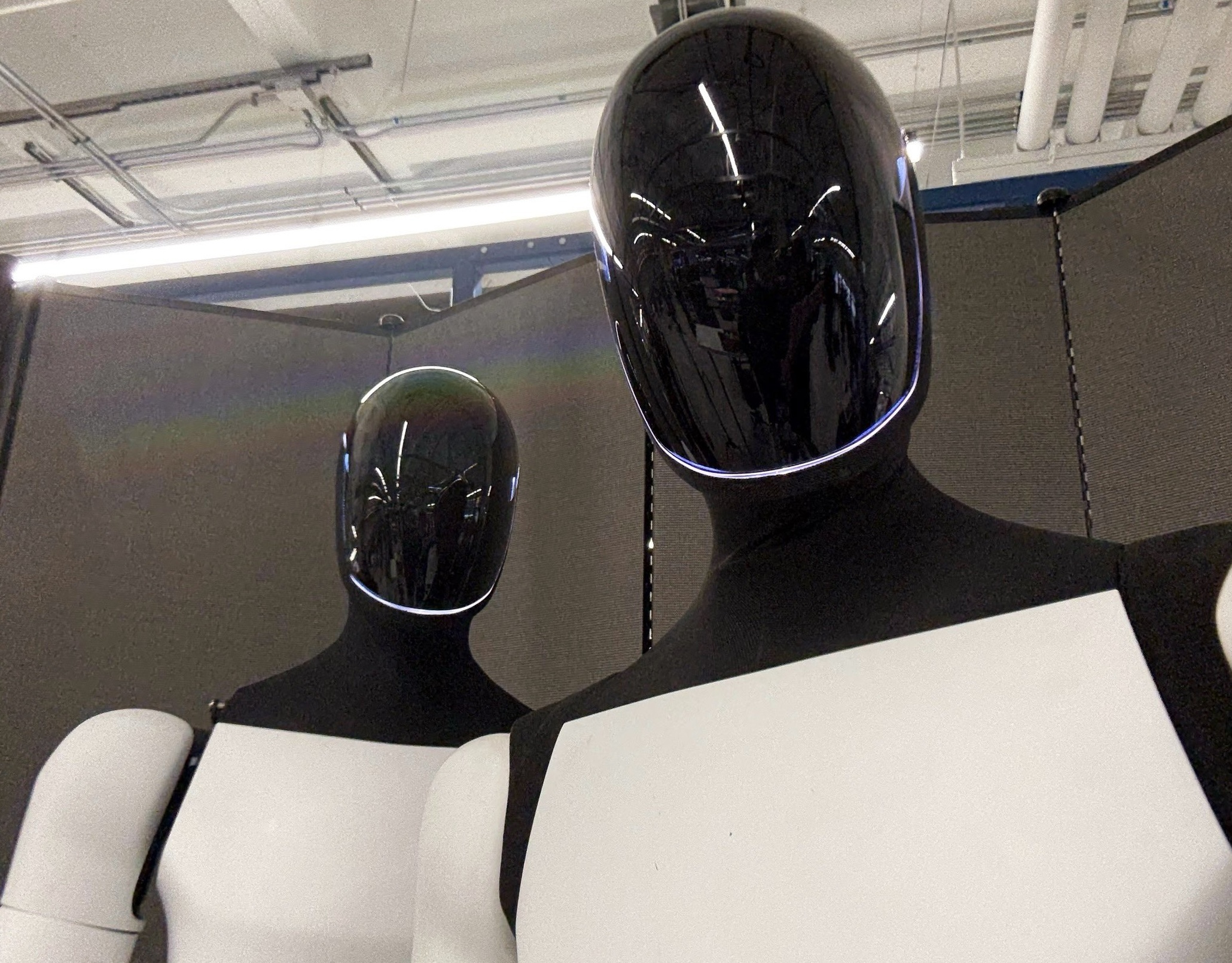
Elon Musk subtly teased Tesla’s strategy to achieve Optimus’ insane production volume targets. The CEO has shared his predictions about Optimus’ volume, and they are so ambitious that one would mistake them for science fiction.
Musk’s recent post on X, however, suggests that Tesla has a plan to attain Optimus’ production goals.
The highest volume product
Elon Musk has been pretty clear about the idea of Optimus being Tesla’s highest-volume product. During the Tesla 2025 Annual Shareholder Meeting, Musk stated that the humanoid robot will see “the fastest production ramp of any product of any large complex manufactured product ever,” starting with a one-million-per-year line at the Fremont Factory.
Following this, Musk stated that Giga Texas will receive a 10 million-per-year unit Optimus line. But even at this level, the Optimus ramp is just beginning, as the production of the humanoid robot will only accelerate from there. At some point, the CEO stated that a Mars location could even have a 100 million-unit-per-year production line, resulting in up to a billion Optimus robots being produced per year.
Self-replication is key
During the weekend, Musk posted a short message that hinted at Tesla’s Optimus strategy. “Optimus will be the Von Neumann probe,” the CEO wrote in his post. This short comment suggests that Tesla will not be relying on traditional production systems to make Optimus. The company probably won’t even hire humans to produce the humanoid robot at one point. Instead, Optimus robots could simply produce other Optimus robots, allowing them to self-replicate.
The Von Neumann is a hypothetical self-replicating spacecraft proposed by the mathematician and physicist John von Neumann in the 1940s–1950s. The hypothetical machine in the concept would be able to travel to a new star system or location, land, mine, and extract raw materials from planets, asteroids, and moons as needed, use those materials to manufacture copies of itself, and launch the new copies toward other star systems.
If Optimus could pull off this ambitious target, the humanoid robot would indeed be the highest volume product ever created. It could, as Musk predicted, really change the world.









